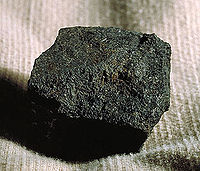
Photo from wikipedia
Biocoke has the potential to reduce the fossil-based materials in metallurgical processes, along with mitigating anthropogenic CO2- and greenhouse gas (GHG) emissions. Reducing those emissions is possible by using bio-based… Click to show full abstract
Biocoke has the potential to reduce the fossil-based materials in metallurgical processes, along with mitigating anthropogenic CO2- and greenhouse gas (GHG) emissions. Reducing those emissions is possible by using bio-based carbon, which is CO2-neutral, as a partial replacement of fossil carbon. In this paper, the effect of adding 5, 10, 15, 30, and 45 wt.% biomass pellets on the reactivity, the physicomechanical, and electrical properties of biocoke was established to assess the possibility of using it as a fuel and reducing agent for a blast furnace (BF) or as a carbon source in a submerged arc furnace (SAF). Biocoke was obtained under laboratory conditions at final coking temperatures of 950 or 1100 °C. Research results indicate that for BF purposes, 5 wt.% biomass additives are the maximum as the reactivity increases and the strength after reaction with CO2 decreases. On the other hand, biocoke’s physicomechanical and electrical properties, obtained at a carbonization temperature of 950 °C, can be considered a promising option for the SAF.
Journal Title: Materials
Year Published: 2022
Link to full text (if available)
Share on Social Media: Sign Up to like & get
recommendations!